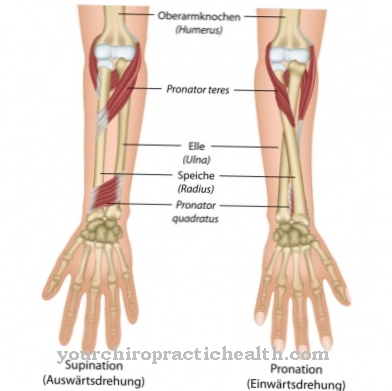In the Reabsorption a substance that has already been excreted is absorbed back into the body. This form of absorption mainly affects the tubular system of the kidneys. Disorders of reabsorption can manifest themselves, for example, in cystinuria.
What is reabsorption?

Resorption is a natural body process. It is the uptake of substances by biological systems. In humans, absorption primarily refers to the absorption of substances from the food pulp, as it takes place in the digestive tract and especially in the intestine. As a rule, this intake relates to breakdown products from food, such as carbohydrates, proteins, vitamins and minerals. However, water, drugs and even toxins can also be absorbed.
In the human body, absorption takes place primarily via the epithelia in the small intestine. However, absorption processes can also affect the kidneys. The kidneys and the liver are considered to be the most important detoxification organs in humans. The kidneys filter toxins out of the blood and process these substances into urine. Medicine distinguishes primary urine from secondary urine.
The actual urine, which we excrete, only emerges in the tubular system of the kidneys. Processes of resorption take place in this system. This type of absorption is also called Reabsorption or reabsorption. In the course of re-absorption, substances are reabsorbed that have actually already been filtered out for excretion. The substances already excreted from certain organs are reabsorbed by cells when they are reabsorbed. In the case of the kidneys, the tubular system channels water and electrolytes from the urine back into the organism, thus creating the actual urine.
Function & task
The tubules together with the kidney corpuscles form the smallest unit of kidney tissue: the so-called nephrons. All renal tubules are connected to one another to form the tubule system of the kidney. The filtration of blood takes place in the glomeruli of the kidneys and corresponds to the formation of primary urine. However, the primary urine still contains substances that the body can actually use, which is why the primary urine is filtered again. Therefore, people do not excrete the primary urine during micturition, but the so-called secondary urine.
This secondary urine is produced by reabsorption processes in the tubular system of the kidneys. During these processes, primarily water, glucose and electrolytes are withdrawn from the primary urine. In this way, reabsorption transports vital substances back into the blood.
Glucose is actively reabsorbed into the blood, for example. In the main part of each renal tubule there is resorption of large amounts of sodium bicarbonate, glucose and amino acids, induced by the symporters and antiporters. These are so-called carrier proteins, which correspond to transmembrane transport proteins and can thus transport substrates across a biomembrane.
The transport processes of the proteins are substance-specific and are based on a conformational change of the molecules. Antiporters to the transport of substances are located in the cell membrane of the renal tubules and transport two different substances in opposite directions. One of the substances is thus absorbed into the cell, while the other substance reaches the extracellular space. The membrane-based symporters in turn carry out a unidirectional transport of various substances. These carrier proteins are found in all resorbing epithelia.
In the main part of the renal tubules, in addition to the reabsorption of the substances mentioned, there is also an absorption or secretion of substances such as uric acid, which is realized by anion transporters and the help of the proximal tubular cells. In the other sections of the tubules, the urine is concentrated by the countercurrent principle. The secondary urine is finally passed into the bladder, where it is collected until the next micturition.
Illnesses & ailments
Some diseases are associated with disorders of renal reabsorption. One such disease is cystinuria, for example. This is an autosomal recessive hereditary tubular-renal transport disorder, which particularly affects the dibasic amino acids arginine, ornithine, lysine and cystine. Of particular clinical relevance is the complication of the disease that causes kidney stones to develop from cystine at an early stage. The prevalence of the disease is given with one affected person in 2000 to 7000 people.
In the disease, the reabsorption of the dibasic amino acids in the proximal tubules of the kidneys is disturbed, so that the concentration of the substances in the urine increases significantly. Because cystine is only poorly soluble in water, crystallization occurs in the acidic environment of the urine, which manifests itself as nephrolithiasis (kidney stones). Those affected can suffer from kidney cholics even in early childhood.
Renal tubular acidosis is also based on a re-absorption disorder. In the case of the type II sub-form, the disturbed reabsorption relates, for example, to hydrogen carbonate (previously known as bicarbonate) and is related to a lack of carbohydrases. The re-absorption defect affects the proximal tubule for bicarbonate and results in chronic metabolic acidosis. The symptomatic loss of potassium and sodium is particularly clinically relevant.The volume depletion and the activating effect on the renin-angiotensin-aldosterone system are also decisive symptoms. There is an increased reabsorption of sodium, so that the potassium losses continue to increase. In children, this disorder of resorption can already cause significant growth disorders or rachitic changes. The disease causes secondary diseases such as osteoporosis in adults.
The third subtype of renal tubular acidosis differs from that of type II in that it is based on reduced sodium reabsorption in the distal tubule. Renal tubular acidosis in the context of this disease is due to a primary defect such as aldosterone resistance.



























